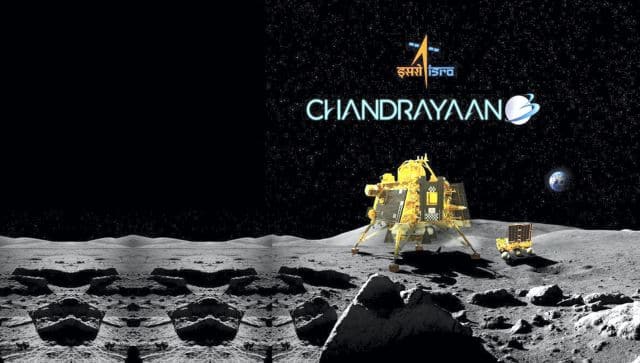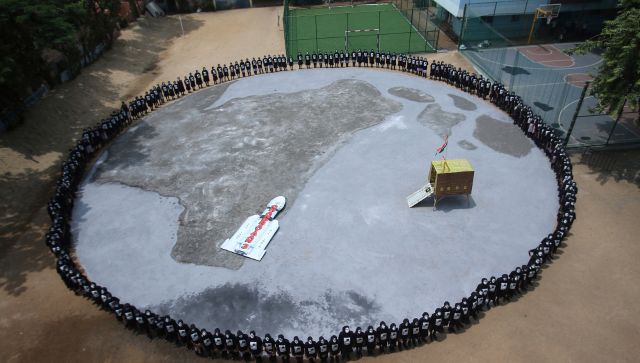India’s Moon mission Chandrayaan-3 has safely landed on the lunar surface. The prayers of billions of Indians were answered as the spacecraft’s lander successfully touched down on the Moon’s south pole, a region that remains unexplored to date. Chandrayaan-3’s lander attempted a soft landing on the lunar surface at 6:04 pm. India has become the first nation to land on the south pole of the Earth’s only natural satellite. Moreover, it has also become the fourth country to soft-land an unmanned craft on the Moon.
But what happens after the lander module’s descent on the Moon? Let’s take a closer look. What happens after Vikram lander’s Moon touchdown? For Indian Space Research Organisation (ISRO), a safe landing was only one (although a major) part of the Moon mission. After the lander module, comprising the lander Vikram and rover Pragyaan, vertically touched down on the Moon, the rover operations will begin and last for one lunar day or 14 Earth days. After the touchdown, a ramp on one side of the Vikram lander will open to roll down the six-wheeled Pragyan rover. As per Times of India (TOI), Pragyan, which has a national tricolour and the logo of ISRO carved on its wheels, will leave the lander and touch the lunar surface after four hours. It will move at a speed of 1cm per second, with its navigation cameras scanning the Moon’s south pole. The lander module has a total of five cameras developed by ISRO’s Space Applications Centre (SAC). As per Indian Express, these cameras will click pictures in the space that will be shared with the public. Three of the four cameras on the lander will play a crucial role in the soft landing, the English daily reported. The rover’s movement on the lunar surface will be within the “lander’s observational radius so that the cameras fitted on the lander will be able to see the rover’s movement at all times”, according to The News Minute (TNM). [caption id=“attachment_13031242” align=“alignnone” width=“640”] An illustration showing a soft landing of Chandrayaan-3 on the lunar surface. PTI File Photo[/caption] ISRO chairman S Somanath told TOI that the “actual distance travelled by the rover during the 14 Earth days can’t be estimated now. Because that will be done based on various things (calculations)”. Scientists at ISRO will be busy analysing the data sent by the instruments and experiments, called payloads, aboard the lander module. Both the lander and rover are carrying a total of six payloads to conduct their own lunar exploration. According to ISRO, the objectives of
India’s third Moon mission
are to mark a safe and soft-landing, to demonstrate the rover moving on the lunar surface and to conduct in-situ scientific experiments. India’s landing has come on the heels of Russia’s Luna-25 mission which failed and crashed on the Moon a few days back. ALSO READ:
Chandrayaan-3: Why is soft-landing on the Moon so challenging?
What will the payloads do? Vikram has four scientific payloads meant to study Moonquakes, changes in the plasma near the surface, and assess the thermal properties of the lunar surface. The payload Radio Anatomy of Moon Bound Hypersensitive ionosphere and Atmosphere (RAMBHA), which will examine the near-surface plasma activities, will help in developing a better understanding of plasma formation and its changes over time, as per the India Today report. Chandra’s Surface Thermo-physical Experiment (ChaSTE) will examine the thermal properties and determine the vertical temperature gradient near the lunar south pole, noted Indian Express. “At its tip, the ChasTE probe has a heater, which will be turned on after a few days to measure thermal conductivity,” Physical Research Laboratory (PRL) director Anil Bhardwaj told the English daily. The payload Instrument for Lunar Seismic Activity (ILSA)’s job is to study lunar quakes. LASER Retroreflector Array (LRA) is designed to measure the distance between Earth and the Moon. The rover has two
payloads
– Alpha Particle X-ray Spectrometer (APXS) and LASER Induced Breakdown Spectroscope (LIBS). These scientific instruments will ascertain the composition of elements in the lunar soil and rocks and study the chemical and mineral composition of the Moon. Why is the Moon mission significant? Moon’s south pole remains a mystery. A successful landing will be a momentous achievement for India, which will pave the way for the country’s emergence as a space power. “Landing on the south pole (of the Moon) would actually allow India to explore if there is water ice on the Moon. And this is very important for cumulative data and science on the geology of the Moon,” Carla Filotico, a partner and managing director at consultancy SpaceTec Partners, told Reuters. This water ice could supply fuel, oxygen and drinking water for space missions in the future. The feat will also boost the Central government’s plan to encourage investment in private space launches and other satellite-based ventures, as per Reuters. With inputs from agencies
An illustration showing a soft landing of Chandrayaan-3 on the lunar surface. PTI File Photo[/caption] ISRO chairman S Somanath told TOI that the “actual distance travelled by the rover during the 14 Earth days can’t be estimated now. Because that will be done based on various things (calculations)”. Scientists at ISRO will be busy analysing the data sent by the instruments and experiments, called payloads, aboard the lander module. Both the lander and rover are carrying a total of six payloads to conduct their own lunar exploration. According to ISRO, the objectives of
India’s third Moon mission
are to mark a safe and soft-landing, to demonstrate the rover moving on the lunar surface and to conduct in-situ scientific experiments. India’s landing has come on the heels of Russia’s Luna-25 mission which failed and crashed on the Moon a few days back. ALSO READ:
Chandrayaan-3: Why is soft-landing on the Moon so challenging?
What will the payloads do? Vikram has four scientific payloads meant to study Moonquakes, changes in the plasma near the surface, and assess the thermal properties of the lunar surface. The payload Radio Anatomy of Moon Bound Hypersensitive ionosphere and Atmosphere (RAMBHA), which will examine the near-surface plasma activities, will help in developing a better understanding of plasma formation and its changes over time, as per the India Today report. Chandra’s Surface Thermo-physical Experiment (ChaSTE) will examine the thermal properties and determine the vertical temperature gradient near the lunar south pole, noted Indian Express. “At its tip, the ChasTE probe has a heater, which will be turned on after a few days to measure thermal conductivity,” Physical Research Laboratory (PRL) director Anil Bhardwaj told the English daily. The payload Instrument for Lunar Seismic Activity (ILSA)’s job is to study lunar quakes. LASER Retroreflector Array (LRA) is designed to measure the distance between Earth and the Moon. The rover has two
payloads
– Alpha Particle X-ray Spectrometer (APXS) and LASER Induced Breakdown Spectroscope (LIBS). These scientific instruments will ascertain the composition of elements in the lunar soil and rocks and study the chemical and mineral composition of the Moon. Why is the Moon mission significant? Moon’s south pole remains a mystery. A successful landing will be a momentous achievement for India, which will pave the way for the country’s emergence as a space power. “Landing on the south pole (of the Moon) would actually allow India to explore if there is water ice on the Moon. And this is very important for cumulative data and science on the geology of the Moon,” Carla Filotico, a partner and managing director at consultancy SpaceTec Partners, told Reuters. This water ice could supply fuel, oxygen and drinking water for space missions in the future. The feat will also boost the Central government’s plan to encourage investment in private space launches and other satellite-based ventures, as per Reuters. With inputs from agencies
)